《Icanplaythepiano.》教学设计
- 格式:doc
- 大小:70.50 KB
- 文档页数:8

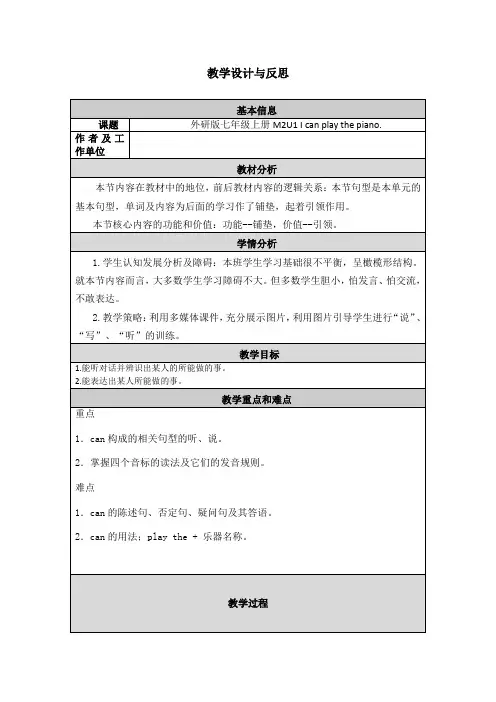
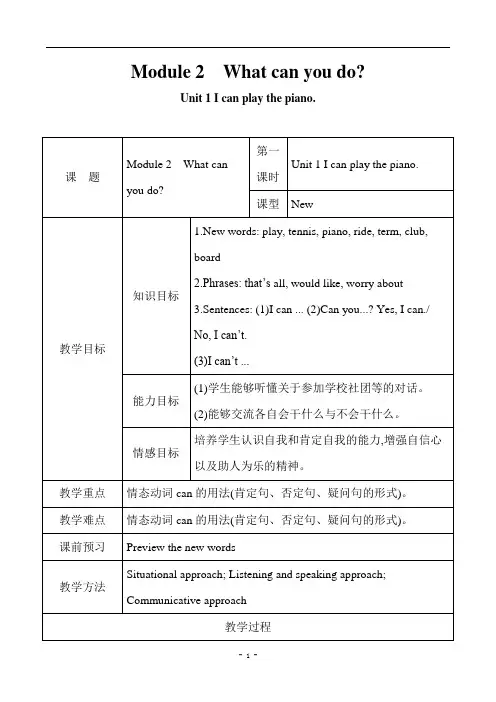
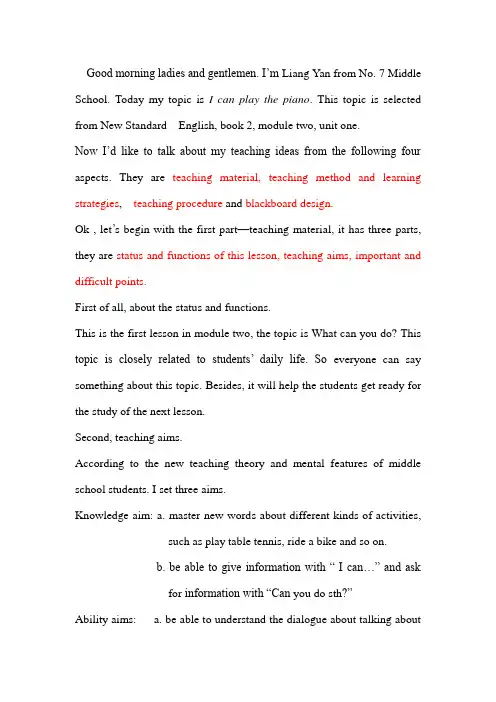
Good morning ladies and gentlemen. I’m Liang Yan from No. 7 Middle School. Today my topic is I can play the piano. This topic is selected from New Standard English, book 2, module two, unit one.Now I’d like to talk about my teaching ideas from the following four aspects. They are teaching material,teaching method and learning strategies, teaching procedure and blackboard design.Ok , let’s begin with the first part—teaching material, it has three parts, they are status and functions of this lesson,teaching aims, important and difficult points.First of all, about the status and functions.This is the first lesson in module two, the topic is What can you do? This topic is closely related to students’ daily life. So everyone can say something about this topic. Besides, it will help the students get ready for the study of the next lesson.Second, teaching aims.According to the new teaching theory and mental features of middle school students. I set three aims.Knowledge aim: a. master new words about different kinds of activities,such as play table tennis, ride a bike and so on.b. be able to give information with “ I can…” and askfor information with “Can you do sth?”Ability aims: a. be able to understand the dialogue about talking aboutone’s ability.b. be able to talk about one’s ability with “sb. can do sth”c. be able to ask for information with “can you do sth?”then answer the question.D be able to choose a club according to one’s ability. Moral aims: a. to cultivate students’ consciousness of good cooperationb. let my students be polite and friendly to others.Third: important and difficult pointsbe able to use “can” properly to describe one’s ability.Now, let’s come to the second part—teaching method and learning strategies.As we all know, the main aims of learning English in middle school is to cultivate their good sense of English language and develop their ability of listening, speaking, reading and writing ability. So, in this lesson, I mainly use task-based teaching appr oach, that’s to say, let my students learn in real situations, gain knowledge by finishing some tasks.When dealing with this lesson, I will also teach my students some learning strategies, such as learn by themselves, work in groups and cooperate with each other.In this lesson, a computer, PPT and some pictures are used to make my teaching more attractive.Next part is teaching procedure.I divide my teaching procedure into five parts. They are warming up, presentation, practice, assessment and homework.Step 1: warming up1.Play an English song “ I can fly” , then ask the students “Do you knowthe name of this song?” They may answer “Yes, it’s I can fly.” In this way , they get to know the meaning of “can”. Then we will practice the structure :A: Can you …?B: Yes, I can/No I can’t.The purpose of warming up is to form a better English learning surrounding for students. At the same time, I will help my students review the knowledge they have learned and prepare for the study of next step.Step 2: presentation.I will mainly talk about this step.First of all, Present a picture with a swimming girl and say “She can swim”. Then ask the students to guess the meaning of the word”can”. It’s very easy for my students to guess the meaning of “can” with the help ofthe picture. It means “能,会”.Next, I will ask a question “ I can swim, what about you?”The students may answer “I can swim. Or I can’t swim.”I’d like to ask every student to say this sentence. After that, I will show some other pictures. For example:When they can talk about their ability with “I can …” or “I can’t …”I’m going to let them work in pairs to practice the dialogueA: Can you …?B: Yes, I can. I can …ListeningTask 1: Listen to the tape and check what activities can you hear . dance cook play the piano ride a bike ride a horseplay table tennis play basketball speak EnglishTask 2:Listen again and find out which club does Daming want to join and why. By listening for the second time, the students may easily find out theanswer: Daming wants to join the music club because he can play the piano.Task 3: Listen for the third time and imitate the dialogue with your parter. Pay attention to their pronunciations and intonation.With the help of tape recorder and PPT, I can set a real situation for the students to understand the dialogue.Step 3: PracticeTask 1: Work in pairs, ask and answer your parter’s ability.A: Can you …?B: Yes, I can/No, I can’t.Task 2: Group workI will Put my students into groups, each groups has four students, and one is the group leader. First , make up a simple dialogue about what they can do. For example “ Can you swim?” “Yes, I can.” “Can you ride a horse?””No, I can’t” then the group leader take notes, and fill in a table. At last, the group leader make a report.Task-based teaching method is used here to develop students’ ability of communication and their skills of cooperation is also well trained.Step 4: AssessmentTalk about their performance in this lesson and encourage them to speak more English after class.Purpose of this step is to stimulate their learning interests.Step 5: HomeworkWrite ten sentences with “ I can…” and “ Can you…?”The last part is blackboard design.。
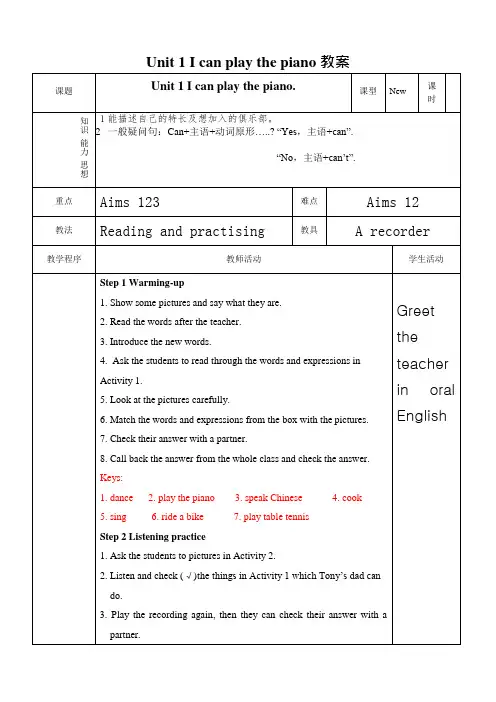
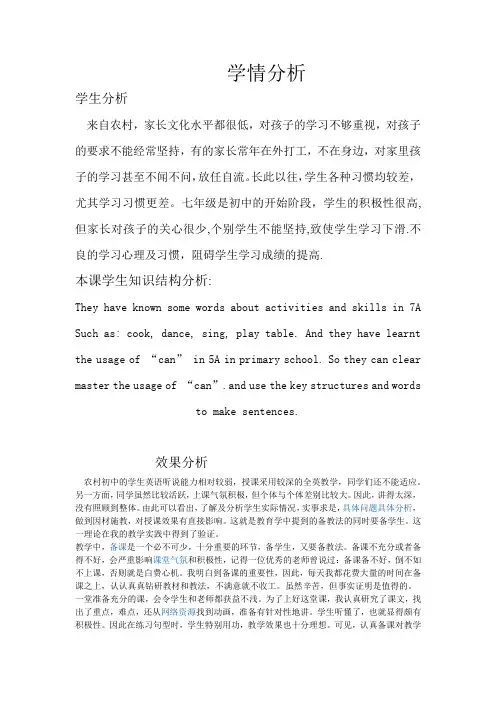
学情分析学生分析来自农村,家长文化水平都很低,对孩子的学习不够重视,对孩子的要求不能经常坚持,有的家长常年在外打工,不在身边,对家里孩子的学习甚至不闻不问,放任自流。
长此以往,学生各种习惯均较差,尤其学习习惯更差。
七年级是初中的开始阶段,学生的积极性很高,但家长对孩子的关心很少,个别学生不能坚持,致使学生学习下滑.不良的学习心理及习惯,阻碍学生学习成绩的提高.本课学生知识结构分析:They have known some words about activities and skills in 7A Such as: cook, dance, sing, play table. And they have learnt the usage of “can” in 5A in primary school. So they can clear master the usage of “can”.and use the key structures and wordsto make sentences.效果分析农村初中的学生英语听说能力相对较弱,授课采用较深的全英教学,同学们还不能适应。
另一方面,同学虽然比较活跃,上课气氛积极,但个体与个体差别比较大。
因此,讲得太深,没有照顾到整体。
由此可以看出,了解及分析学生实际情况,实事求是,具体问题具体分析,做到因材施教,对授课效果有直接影响。
这就是教育学中提到的备教法的同时要备学生。
这一理论在我的教学实践中得到了验证。
教学中,备课是一个必不可少,十分重要的环节,备学生,又要备教法。
备课不充分或者备得不好,会严重影响课堂气氛和积极性,记得一位优秀的老师曾说过:备课备不好,倒不如不上课,否则就是白费心机。
我明白到备课的重要性,因此,每天我都花费大量的时间在备课之上,认认真真钻研教材和教法,不满意就不收工。
虽然辛苦,但事实证明是值得的。
一堂准备充分的课,会令学生和老师都获益不浅。
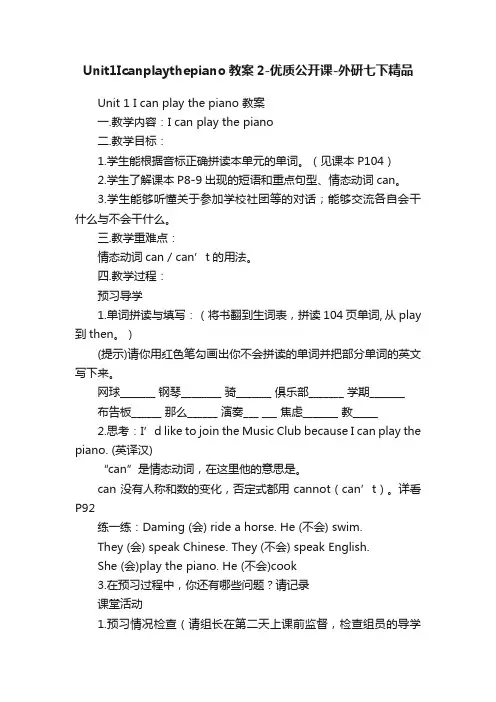
Unit1Icanplaythepiano教案2-优质公开课-外研七下精品Unit 1 I can play the piano 教案一.教学内容:I can play the piano二.教学目标:1.学生能根据音标正确拼读本单元的单词。
(见课本P104)2.学生了解课本P8-9出现的短语和重点句型、情态动词can。
3.学生能够听懂关于参加学校社团等的对话;能够交流各自会干什么与不会干什么。
三.教学重难点:情态动词can / can’t的用法。
四.教学过程:预习导学1.单词拼读与填写:(将书翻到生词表,拼读104页单词, 从play 到then。
)(提示)请你用红色笔勾画出你不会拼读的单词并把部分单词的英文写下来。
网球_______ 钢琴________ 骑_______ 俱乐部_______ 学期_______布告板______ 那么______ 演奏___ ___ 焦虑_______ 教_____2.思考:I’d like to join the Music Club because I can play the piano. (英译汉)“can”是情态动词,在这里他的意思是。
can没有人称和数的变化,否定式都用cannot(can’t)。
详看P92练一练:Daming (会) ride a horse. He (不会) swim.They (会) speak Chinese. They (不会) speak English.She (会)play the piano. He (不会)cook3.在预习过程中,你还有哪些问题?请记录课堂活动1.预习情况检查(请组长在第二天上课前监督,检查组员的导学案以及课文预习情况)①单词拼读PK大赛(小组展示)拼读PK赛。
小组齐读本组单词Group1: play—piano Group2: ride—term Group3: board—well。
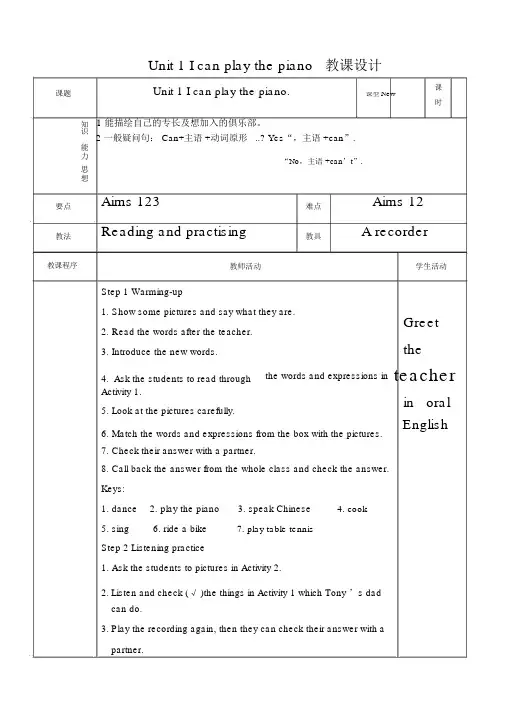
Unit 1 I can play the piano教课设计课题Unit 1 I can play the piano.课课型New时知 1 能描绘自己的专长及想加入的俱乐部。
识2 一般疑问句: Can+主语 +动词原形 ..? Yes“,主语 +can”.能力思想“No,主语 +can’t”.要点教法教课程序Aims 123难点Aims 12Reading and practising教具A recorder教师活动学生活动Step 1 Warming-up1.Show some pictures and say what they are.Greet2.Read the words after the teacher.3.Introduce the new words.the4.Ask the students to read through the words and expressions in teacher Activity 1.in oral5.Look at the pictures carefully.6. Match the words and expressions from the box with the pictures.English7.Check their answer with a partner.8.Call back the answer from the whole class and check the answer.Keys:1. dance2. play the piano3. speak Chinese4. cook5. sing6. ride a bike7. play table tennisStep 2 Listening practice1.Ask the students to pictures in Activity2.2.Listen and check (√ )the things in Activity 1 which Tony ’s dadcan do.3.Play the recording again, then they can check their answer with apartner.4.Call back the answer from the whole class and check the answer. Step 3 Listen and read.1.Ask the students to read the conversation silently.2.Play the recording and ask the students to listen and read the conversation.3.Read the conversation.4.Act it out.5.Ask the students to check √() the clubs they want to join.6.Ask the students to check with a partner.7.Play the recording again .Check the answers:Club Music Club Dance Table Tennis Club Food and Dri Name ClubDaming√Betty√Lingling√Tony√Step 4 Complete the passage.1. Ask the students to read the words in the box in Activity 4.board choose club music term2. Read through the passage.Can you cook? No? Join the Food and Drink (1) __________. Can you play the piano? Join the (2) __________ Club. What about dancing? (3) __________ the Dance Club. There are lots of new clubs every (4) __________. They’re all on the (5) __________ and you can choose your favourite.plete the passage with the correct form of the words from the box.4.Ask the students to check with a partner.5.Check the answers:Keys: 1. Club 2. Music 3. Choose 4. term 5. board6.Learn “Everyday English”Look!What about you?Don’tworry about .Step 5 Pronunciation and speaking.1.Say the sentences in Activity 5 aloud./k?n/I can play piano./ka: nt/I can’tspeak Chinese very well./k?n/Can you cook?2.Listen and repeat.3.Learning to learnIn English, we pronounce a word in different ways when it is stressed or not stressed. In“Yes, I can”, we pronounce can as /k?n/; in “Oh, good. You can come to help us”, we pronounce can as /k?n/.4.Play the recording once without stopping.5.Listen and repeat in Activity6./i:/ Chinese she we/e/ egg tennis/i/ English5.Ask the students to practice the sounds in pairs.Step 6 Guessing game.1.Show some pictures.2.According to the information given and ask the students toguess what it is.3.Show the pictures to check the answers.Step 7 Work in pairs.Can Can’tDaming speak Chinese play the piano danceBetty speak English cook play table tennis Lingling speak Chinese dance cookTony play table tennis speak English speak Chinese well1.Look at the information.2.Read through the example with the class.—Can Betty speak English?—Yes, she can.—Can Tony speak Chinese well?—No, he can’t.3.Pair them to ask and answer.4.Circulate and monitor their production.Step 8 Do exercises:一、单项选择:()1. —What can you do, Lingling?—I can __________.A. play the footballB. ride bikeC. play the pianoD. play a basketball()2. I can sing English songs ________ I can dance.A. andB. soC. orD. but()3. He can sing, ________ he can cook’t.A. andB. soC. orD. but()4. —Can Jim play basketball?—______________.A. Yes, I canB. Yes, he canC. No, you can’ tD. No, he isn ’ t.()5. —Can you speak English well?—_________.A. No, I can’ tB. Yes, I haveC. No, I don’ tD. Yes, I Do some exercise ineach group.speakKeys: 1. C 2. A 3. D 4. B 5. A二、达成句子:1.Tony,你会说中文吗?________ you _______________, Tony?2.这学期新的俱乐部名单在宣布板上。
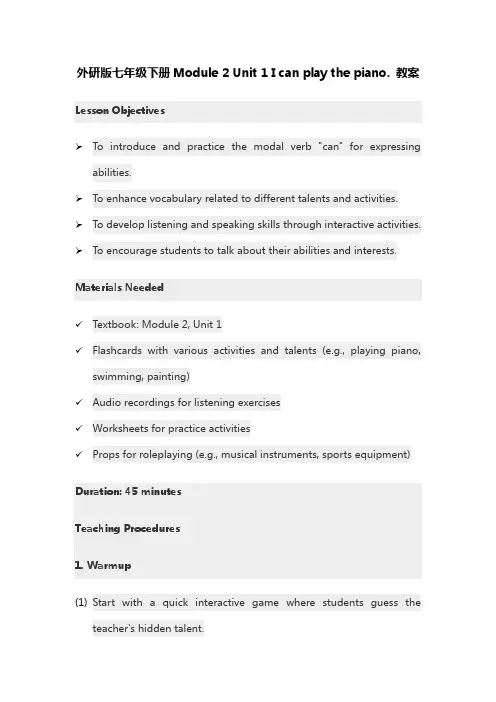
外研版七年级下册Module 2 Unit 1 I can play the piano. 教案Lesson Objectives➢To introduce and practice the modal verb "can" for expressing abilities.➢To enhance vocabulary related to different talents and activities.➢To develop listening and speaking skills through interactive activities.➢To encourage students to talk about their abilities and interests. Materials Needed✓Textbook: Module 2, Unit 1✓Flashcards with various activities and talents (e.g., playing piano, swimming, painting)✓Audio recordings for listening exercises✓Worksheets for practice activities✓Props for roleplaying (e.g., musical instruments, sports equipment) Duration: 45 minutesTeaching Procedures1. Warmup(1)Start with a quick interactive game where students guess theteacher's hidden talent.(2)Lead a brief discussion on different talents and interests.2. Vocabulary Introduction1)Introduce new vocabulary related to talents and activities (e.g., playthe piano, swim, sing, dance).2)Use flashcards to illustrate and reinforce these words.3)Engage students in pronunciation practice and simple Q&A using thenew vocabulary.3. Grammar: Introduction to "Can"(1)Explain the use of the modal verb "can" for expressing ability.(2)Illustrate positive, negative, and question forms (e.g., “I can swim.”,“I can’t dance.”, “Can you play the piano?”).(3)Conduct a drill exercise for practice.4. Listening Activity1)Play audio clips that include dialogues or short stories using themodal verb "can" in various contexts.2)Ask prehension questions to ensure students understand the contentand the use of "can."5. Speaking Activity: Talent Show(1)Organize a classroom 'Talent Show' where each student says whatthey can do using the new vocabulary and structure (e.g., "I can play the guitar.").(2)Encourage students to use props for a more engaging and realisticexperience.6. Practice Worksheet1)Distribute worksheets with exercises related to the use of "can" andthe vocabulary learned.2)Include matching exercises, fillintheblanks, and short dialoguecreation.Homework AssignmentAsk students to write a short paragraph about their family members’talents using “can.”Assessment(1)Observe students' participation and ability to use the modal verb"can" correctly during activities.(2)Review worksheets to assess understanding and correct usage ofvocabulary and grammar.Closure✧Summarize the key learning points of the lesson.✧Encourage students to continue practicing talking about theirabilities and interests in English.。
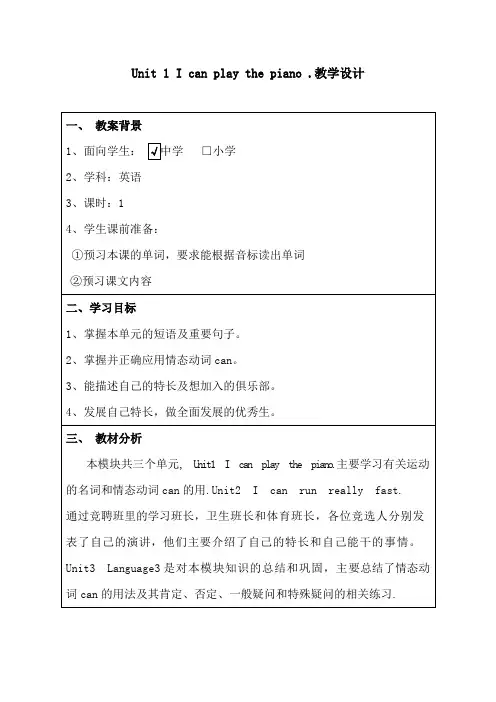
Unit 1 I can play the piano .教学设计一、教案背景1、面向学生:√中学□小学2、学科:英语3、课时:14、学生课前准备:①预习本课的单词,要求能根据音标读出单词②预习课文内容二、学习目标1、掌握本单元的短语及重要句子。
2、掌握并正确应用情态动词can。
3、能描述自己的特长及想加入的俱乐部。
4、发展自己特长,做全面发展的优秀生。
三、教材分析本模块共三个单元,U n i t1I c a n p l a y t h e p i a n o.主要学习有关运动的名词和情态动词can的用.Unit2 I can run really fast.通过竞聘班里的学习班长,卫生班长和体育班长,各位竞选人分别发表了自己的演讲,他们主要介绍了自己的特长和自己能干的事情。
Unit3 Language3是对本模块知识的总结和巩固,主要总结了情态动词can的用法及其肯定、否定、一般疑问和特殊疑问的相关练习.四、教学过程[课前朗读]跟录音朗读单词play tennis piano ride club term board would like well all worry teach then 牢固地形成正确语音,注意读词时先看音标再看单词,让学生逐渐养成音、形结合背单词的习惯。
[检测]:a.小组内只看音标朗读单词,组长注意订正不正确的发音。
b.利用音标和汉语提示来检查单词的拼写。
利用图片完成短语的翻译:弹钢琴骑自行车跳舞说英语打乒乓球做饭(并写在作业本上)(一)、情境导入1、教师可问学生:What can you do?以此来引导学生,叙述自己能干的事情,引发学生的兴趣,调动学生的思维,导入本课。
练习句型:A: What can Tfboys do ? A: What can YaoMing do ?B:They can sing songs. B:He can play basketball.A: What can you do?B:I can play basketball .(二)、小听力(自主完成,合作释疑)Look at the pictures . Listen and check (√)the things which Tony’s dad can do .(三)、多层听1. Listen and answer the questions .(1)How many clubs are there ?( 2) What are they ?2. listen and find out the missing words.•Daming would like to _____ the Music Club because he can play the_____.•Betty ____ cooking ,so she can jion the Food and Drink Club.•Tony can’t speak Chinese very ____.He can play _____ _____ .3.听后读(careful reading )仔细阅读activity3,填写表格,完成后小组内交流答案。
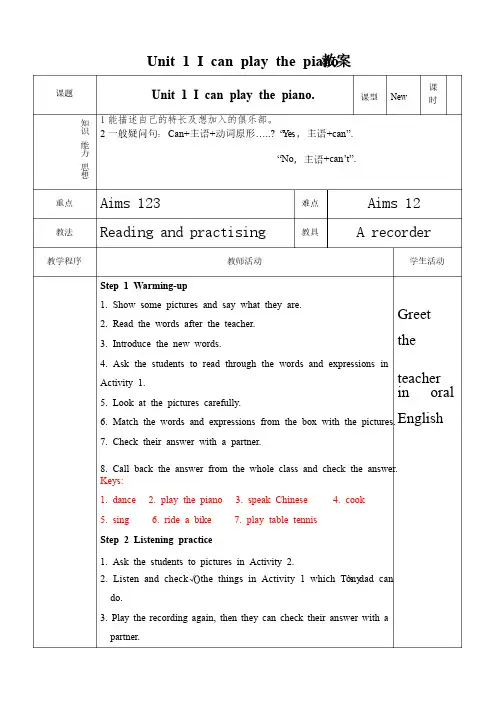
Unit 1 I can play the piano 教案课题课题Unit 1 I can play the piano. 课型课型 New 课时知识能力思想1能描述自己的特长及想加入的俱乐部。
2一般疑问句:Can+主语+动词原形…..? “Y es ,主语+can +can””. “No ,主语+can +can’’t ”. 重点重点 Aims 123难点难点 Aims 12 教法教法 Reading and practising教具教具A recorder教学程序教学程序教师活动教师活动学生活动学生活动Step 1 Warming-up 1. Show some pictures and say what they are. 2. Read the words after the teacher. 3. Introduce the new words. 4. 4. Ask Ask the the students students to to read read through through the the words words and and expressions expressions in in Activity 1. 5. Look at the pictures carefully. 6. Match the words and expressions from the box with the pictures. 7. Check their answer with a partner. 8. Call back the answer from the whole class and check the answer. Keys: 1. dance 2. play the piano 3. speak Chinese 4. cook 5. sing 6. ride a bike 7. play table tennis Step 2 Listening practice1. Ask the students to pictures in Activity 2. 2. Listen and check (√)the things in Activity 1 which Tony ’s dad can do. 3. 3. Play Play the the recording recording again, again, then then they they can can check check their their answer answer with with a a partner. Greet the teacher in oral English 4. Call back the answer from the whole class and check the answer. Step 3 Listen and read.1. Ask the students to read the conversation silently. 2. 2. Play Play the the recording recording and and ask ask the the students students to to listen listen and and read read the the conversation. 3. Read the conversation. 4. Act it out. 5. Ask the students to check (√) the clubs they want to join. 6. Ask the students to check with a partner. 7. Play the recording again .Check the answers: Step 4 Complete the passage. 1. Ask the students to read the words in the box in Activity 4. board choose club music term 2. Read through the passage. Can you cook? No? Join the Food and Drink (1) __________. Can you you play play the the piano? piano? Join Join the the (2) (2) __________ __________ Club. Club. What What about about dancing? dancing? (3) (3) __________ __________ the the Dance Dance Club. Club. There There are are lots lots of of new new clubs every (4) __________. They ’re all on the (5) __________ and you can choose your favourite. 3. Complete the passage with the correct form form of the words from of the words from the box. 4. Ask the students to check with a partner. 5. Check the answers: Keys: 1. Club 2. Music 3. Choose 4. term 5. board Club Name Music Club Dance Club Table Tennis Club Food and DriDaming √ Betty √ Lingling √ Tony √6. Learn “Everyday English ” Look! What about you? Don Don’’t worry about…. Step 5 Pronunciation and speaking. 1. Say the sentences in Activity 5 aloud. /k /kəən/ I can play piano. /k a:nt/ I can ’t speak Chinese very well. /kæn/ Can you cook? 2. Listen and repeat. 3. Learning to learn In In English, English, we we pronounce pronounce a a word word in in different different ways ways when when it it is is stressed or not stressed. In “Yes, I can ”, we pronounce can as /kæn/; in “Oh, good. You can come to help us ”, we pronounce can as /k ən/. 4. Play the recording once without stopping. 5. Listen and repeat in Activity 6. /i:/ Chinese she we /e/ egg tennis /i/ English 5. Ask the students to practice the sounds in pairs. Step 6 Guessing game. 1. Show some pictures. 2. According to the information given and ask the students to guess what it is. 3. Show the pictures to check the answers. Step 7 Work in pairs. Can Can Can’’t Daming speak Chinese play the piano dance Betty speak English cook play table tennis Lingling speak Chinese dance cook 1. Look at the information. 2. Read through the example with the class. —Can Betty speak English? —Yes, she can. —Can Tony speak Chinese well? —No, he can’t. 3. Pair them to ask and answer. 4. Circulate and monitor their production. Step 8 Do exercises: 一、单项选择:一、单项选择:( )1. —What can you do, Lingling? —I can __________. A. play the football B. ride bike C. play the piano D. play a basketball ( )2. I can sing English songs ________ I can dance. A. and B. so C. or D. but ( )3. He can sing, ________ he can’t cook. A. and B. so C. or D. but ( )4. —Can Jim play basketball? —______________. A. Yes, I can B. Yes, he can C. No, you can’t D. No, he isn’t.( )5. —Can you speak English well? — _________. A. No, I can’t B. Yes, I have C. No, I don’t D. Yes, I speak Keys: 1. C 2. A 3. D 4. B 5. A 二、完成句子:二、完成句子:1. Tony ,你会说中文吗?,你会说中文吗?________ you _______________, Tony? 2. 这学期新的俱乐部名单在公布板上。
七年级下册《I can play the piano》学案新版外研版课件www.5yk 七年级下册《Icanplaythepiano》学案新版外研版Unit1Icanplaythepiano一、教学内容:Unit1Icanplaythepiano.二、课型:Listeningandspeaking三、教学目标:3、能够对他人能做某事等方面进行问答。
4、能运用目标语言表达自己在某一方面所具备的才能。
四、教学重难点:、能够听懂别人能做某事并能在听力中找出Daming/Betty/Lingling/Tony相关的细节信息,完成任务。
(重点)2、能够对他人能做某事等方面进行简单的描述以及进行问答。
(难点)五、教学准备:PPT、教学挂图、录音机、课堂联系表格、奖品。
六、教学过程:教学步骤教师活动学生活动设计意图Lead-in、organizetheSstohaveachat.2、Freetalkabout“whatcanyoudo?”/“canyoudosth?”、Haveachat.2、Askandanswer:Icanplaybasketball.canyouplaybasketball?yes,Ican./No,Ican’t.通过这个环节既能活跃课堂气氛,又能为以下教学内容作好铺垫Step2Pre-task、Newwordslearning:ShowsomepicturesandgettheSssaylikethis:Ican……2、HavetheSstomatchthewordsandexpressionsfromtheboxwit hthepicturesinActivity1.3、organizetheSstoaskandanswerinpairs.A:canyou…?A:canhe/she…?B:yes,Ican./No,can’tB:yes,he/shecan./No,he/shecan’t.、Lookatthepicturesandsaylikethis:Icancook,playtennis,rideabike…2、matchthewordsandexpressionsfromtheboxwiththepicture sinActivity1.3、AskandanswerinpairsaccordingtothepicturesA:canyou…?B:.yes,Ican./No,can’tA:canhe/she…?B:yes,he/shecan./No,he/shecan’t.引导学生直观谈论图片,训练学生的口头表达能力,在描述图片的同时学习新单词和新句型。
外研版七下Modue 2 What can ou do
Unit 1 I can board woud ie we a worr teach then 牢固地形成正确语音,注意读词时先看音标再看单词,让学生逐渐养成音、形结合背单词的习惯。
[检测]:a小组内只看音标朗读单词,组长注意订正不正确的发音。
b利用音标和汉语提示来检查单词的拼写。
利用图片完成短语的翻译:弹钢琴骑自行车跳舞说英语打乒乓球做饭(并写在作业本上)
二、情境导入
1、教师可问学生:What can ou do?以此来引导学生,叙述自己能干的事情,引发学生的兴趣,调动学生的思维,导入本课。
练习句型:A: What can Tfbo do A: What can YaoMing do
B:The can ing ong B:He can an cub are there 2 What are the
2 iten and find out the miing word
Daming woud ie to _____ the Muic Cub becaue he can ing woud ie to oin the muic cub becaue he can grouuic cub, becaue he can ing
七、归纳短语
1、通过学习Activit 3,让学生归纳本课短语,小组间补充完善。
2、朗读短语直至背熟。
3、默写,组长检查,出错的及时进行纠正和巩固。
八、Homewor
1、总结情态动词can的用法。
2、教师鼓励学生用本课所学句型,介绍自己能干的事情,使语言点在具体应用中得到巩固。